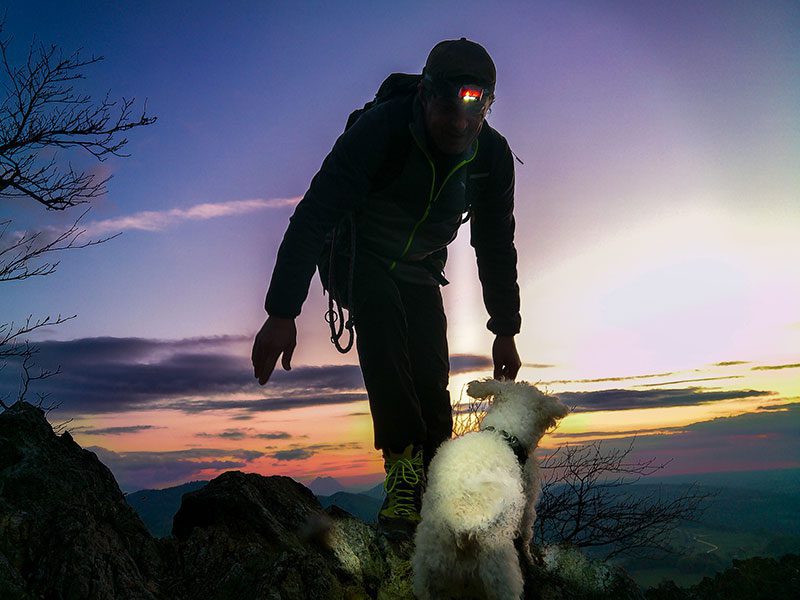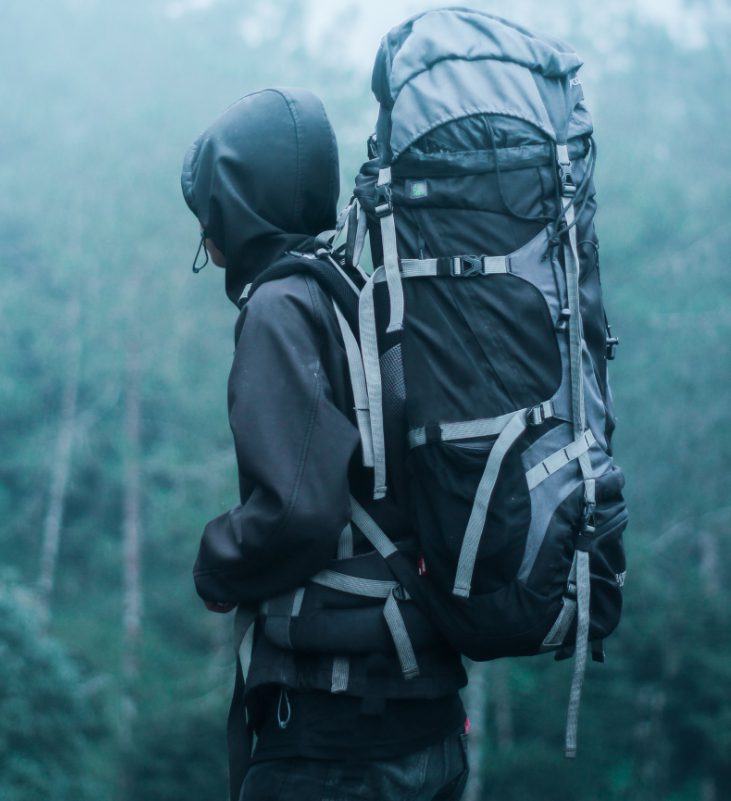Hello and Servus from the Salzkammergut (Salzburg, Austrian Alps) on the topic of ‚Winter Mountain Layering Guide.‘
The cold mountain air bites, and the snow crunches under your hiking boots. Winter hiking in the mountains is an unforgettable experience, but it requires careful preparation.
Whether you’re hiking with or without a dog, the right clothing is crucial.
In this Winter Mountain Layering Guide, I share my experiences and tips for the so-called „Layering Principle“ to ensure you are well-prepared.
The Layering Principle: Perfectly Dressed for Winter Mountain Tours.
Links witdh [*] or Amazon Icon are Ads
Gear and equipment reviews for mountain tours and hikes
The Basics: Why is it so important and what to consider with the Layering Principle?
The Layering Principle is important because it allows you to adapt optimally to changing weather conditions, ensuring a safe and comfortable journey in the mountains.

Here are some reasons why the Layering Principle is crucial
- Flexibility: As temperatures in the mountains can change quickly, the Layering Principle allows you to adapt flexibly. You can easily add or remove layers depending on whether you feel too warm or too cold.
- Moisture Control: Hiking, even in cold weather, can make you sweat. The Layering Principle allows you to wick moisture away from the skin while staying warm. The baselayer transports sweat away, while the outer layer protects against wind and moisture.
- Protection against Hypothermia: The insulation layer ensures that your body heat is retained. When cooling down, it helps preserve warmth and prevent hypothermia.
- Protection against Overheating: If you get warm during your mountain tour, you can simply remove a layer to avoid overheating. This is crucial as overheating can be as dangerous as hypothermia.
- Weight and Comfort: The Layering Principle allows you to dress lightly, avoiding the need for too many thick garments. This maintains good freedom of movement.
In summary, the Layering Principle ensures that you are optimally dressed for your winter mountain tours, protecting you from both cold and overheating.
It’s a proven – and for me, clearly the best – method to make winter mountain tours (with your dog) safe and enjoyable. Trust me 😉

The Baselayer: Underwear that keeps you dry
A „Base-Layer“ is the bottom layer of your clothing when applying the Layering Principle, especially crucial for winter mountain tours.

The Base-Layer, also known as functional underwear, lies directly on your skin and serves several important functions:
- Moisture Management: The main task of the Baselayer is to wick moisture away from your skin. When hiking, this layer transports sweat from the skin to the outer layers, where it can evaporate. This keeps your skin dry and helps avoid hypothermia.
- Isolation: A high-quality Base-Layer can provide insulation to retain body heat. This is crucial in colder conditions to keep you warm.
- Comfort: A good Baselayer fits snugly without being uncomfortable, minimizing friction and preventing skin irritations. It contributes to overall comfort.
- Odor Control: Many modern Baselayers are made of materials like Merino wool, which has natural antibacterial properties, inhibiting odor formation. This is especially important for longer hikes.
Regarding materials, Merino wool and synthetic materials like polyester and polypropylene are common options for Baselayers.
Merino wool is popular among many hikers (I’m a fan 😎 ) because it effectively wicks moisture, is odor-resistant, and provides warmth. However, synthetic materials are often lighter and dry faster.
The Base-Layer is the fundamental layer on which you build the Layering Principle.
Depending on the temperature and personal preferences, you choose your Base-Layer accordingly to stay comfortable and safe on your winter mountain tours.
Here you can find more information, details, and recommendations about Baselayers in the MAG.
The Midlayer: the warming and insulating layer
A „Midlayer“ – the second Layer in this Winter Mountain Layering Guide – is the midayer of your clothing, part of the Layering Principle for winter mountain tours.
This layer is between the Base-Layer (functional underwear) and the Outer-Layer (outer layer like jacket and pants).
The Midlayer or: Mid-Layer – has various tasks:
- Isolation: The main function of the Mid-Layer is to provide additional insulation to retain body heat. In cold conditions, this layer acts as a barrier against the cold and keeps you warm.
- Moisture Management: A good Midlayer wicks moisture away from the Baselayer and distributes it over a larger surface for easier evaporation. This helps maintain a dry and warm body climate.
- Comfort and Freedom of Movement: The Midlayer should be cut in a way that allows sufficient freedom of movement. It shouldn’t be too tight to ensure good circulation and flexibility.
The Midlayer can consist of various materials, including fleece, down, or synthetic insulation materials.

Fleece Mid-Layers are popular among many hikers as they are lightweight, warm, and quick-drying.
Down Midlayers provide excellent insulation but are less moisture-resistant. Synthetic insulation materials offer a good compromise between insulation and moisture management.
The choice of the Midlayer depends on specific weather conditions, your activity level, and personal preferences.
Here you can find more information, details, and recommendations about Mid-Layers in the MAG.
The Shell Layer: The outer layer as weather protection
A „Shell Layer“ is the outermost layer of your clothing when applying the layering principle, especially during winter mountain tours.
This layer, often referred to as „Shell“ or „Outer-Layer,“ primarily serves to protect you from external elements such as wind, rain, and snow.
Functions of the Shell Layer:
- Weather Protection: The main task of the Shell Layer is to protect you from wind, rain, snow, and other external weather conditions. It blocks moisture and wind, keeping them away from your body.
- Breathability: Simultaneously, the Shell Layer should be breathable to wick moisture from the inside to the outside. This prevents you from getting wet and cold from your own sweat.
- Durability: The Outer-Layer should be robust and durable, as it undergoes the most wear and tear when navigating rough terrain or rubbing against rocks and trees.
In general, I carry a Shell Layer in my backpack and put it on when the weather worsens. This allows you to stay flexible and adapt to changing conditions, a crucial part of safety and comfort during mountain tours.
Types of Shell Layers include:
- Hardshell: Typically made from waterproof, windproof materials like Gore-Tex. They provide maximum protection against the elements and are ideal in heavy rain and snow.
- Softshell: More breathable and flexible than Hardshells, offering good weather protection. Suitable for moderate conditions, providing more freedom of movement.
- Windbreaker: Ultralight and mainly designed to block the wind. They are less waterproof, making them best for dry, windy conditions.
Your choice of Shell Layer depends on the specific weather conditions.
For more information, details, and recommendations on Shell Layers, check out the MAG.
Useful Accessories and Details
Head, hands, and feet are particularly vulnerable to cold.
A warm hat, gloves, waterproof boots, or shoes with warm socks are essential. Don’t forget to bring sunglasses and sun protection for sunny winter days, as the reflective snow cover can intensify UV radiation.

Checklist for your Winter Tour using the Layering Principle
A Tip for the Start: Perfectly Dressed, but Not Overloaded
A common mistake is overloading with too many layers. Remember that you are in motion during the tour and will warm up.
Start with one layer less and add as needed. The layering principle thrives on its flexibility.
A Final Thought to my Winter Mountain Layering Guide: Adaptation and Safety
Winter mountain adventures can be unpredictable. Continuously observe the weather conditions and adjust your clothing accordingly. Safety always comes first, so don’t overestimate yourself and turn back in time if conditions worsen. Your safety and that of your dog are paramount.
How do you prepare for winter hikes? Do you have any questions about the layering principle? Share your experiences and thoughts in the comments.
Together, we can ensure that your winter adventures in the mountains are unforgettable. I look forward to it – and as always: stay on the path!
Further Knowledge, Experiences, and Recommendations
Explore more on topics related to mountain adventures, equipment, and tips.
Gear and equipment reviews for mountain tours and hikes
Tips, Experiences, and Knowledge for Mountain Tours and Hiking







